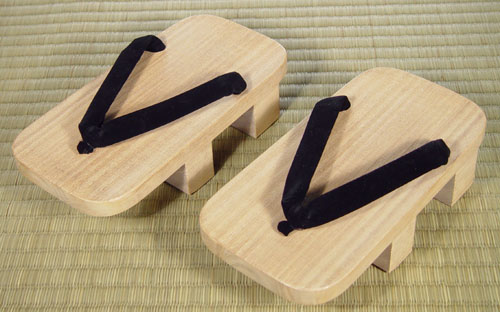Geta
Geta are a form of traditional Japanese footwear that resembles both clogs and flip-flops. They are a kind of sandal with an elevated wooden base held onto the foot with a fabric thong to keep the foot well above the ground. Usually worn with Tabi. They are worn with traditional Japanese clothing such as kimono or yukata, but (in Japan) also with Western clothing during the summer months. Sometimes geta are worn in rain or snow to keep the feet dry, due to their extra height and impermeability compared to other shoes such as zori.
Styles
There are several different styles of geta. The most familiar style in the West consists of an unfinished wooden board called a dai, (stand) that the foot is set upon, with a cloth thong (hanao) that passes between the big toe and second toe. As geta are usually worn only with yukata or other informal Japanese clothes or Western clothes, there is no need to wear socks. Ordinary people wear at least slightly more formal zori when wearing special toe socks called tabi. Apprentice geisha, also called "maiko", wear their special geta (see below) with tabi to accommodate the hanao.
The two supporting pieces below the base board, called "teeth" (ha), are also made of wood, usually very light-weight kiri (paulownia) and make a distinctive "clacking" sound while walking: karankoron. This is sometimes mentioned as one of the sounds that older Japanese miss most in modern life. A traditional saying in Japanese translates as "You don't know until you have worn geta." This means roughly, "you can't tell the results until the game is over."
Construction
The dai may vary in shape: oval ("more feminine") to rectangular ("more masculine") and color (natural, lacquered, or stained). The ha may also vary in style; for example, tengu-geta have only a single centered "tooth". There are also less common geta with three "teeth". Merchants use(d) very high geta (two long "teeth") to keep the feet well above the seafood scraps on the floor. The "teeth" are usually not separate, instead, the geta is carved from one block of wood. The tengu "tooth" is, however, strengthened by a special attachment. The "teeth" of any geta may have harder wood drilled into the bottom of the "teeth" to avoid splitting, and the soles of the "teeth" may have rubber soles glued onto them.
The hanao can be wide and padded, or narrow and hard, and it can be made with many sorts of fabric. Printed cotton with traditional Japanese motifs is popular, but there are also geta with vinyl and leather hanao. Inside the hanao is a cord (recently synthetic, but traditionally hemp) that is knotted in a special way to the three holes of the dai. In the wide hanao there is some padding as well. The hanao are replaceable. It sits between the two first toes because having the thong of rectangular geta anywhere but the middle would result in the inner back corners of the geta colliding when walking. Recently, as Western shoes have become more popular, more Western looking geta have been developed. They are more round in shape, may have an ergonomically shaped dai, a thick heel as in Western clogs, instead of separate "teeth", and the thong at the side as in flip-flops. According to Japanese superstition, breaking the thong on one's geta is considered very unlucky.
